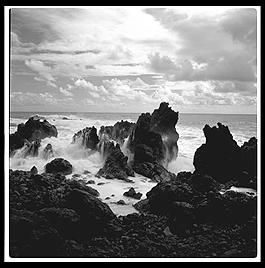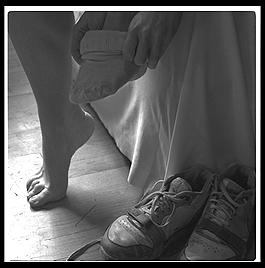 Photographic Materials and Processes by
Leslie Stroebel, John Compton, Ira Current, and Richard Zakia (1986 Focal Press,
608 pp, was $64.95 hardcover but is now out of print, ISBN
0-240-51752-0; a stripped down 400pp version is Basic Photographic
Materials and Processes, $54.95 softcover, ISBN 0-240-80405-8, order from
amazon.com
.
Photographic Materials and Processes by
Leslie Stroebel, John Compton, Ira Current, and Richard Zakia (1986 Focal Press,
608 pp, was $64.95 hardcover but is now out of print, ISBN
0-240-51752-0; a stripped down 400pp version is Basic Photographic
Materials and Processes, $54.95 softcover, ISBN 0-240-80405-8, order from
amazon.com
.
This book is the basis of a one-year course at the Rochester Institute of
Technology, the world's premiere school of photography. It is comprehensive and
nearly every page contains useful information that will affect the way you take
pictures.
Control of contrast and density is the sine qua non of great photographers and
that's where Stroebel starts. If you wanted to know how the curve that defines a
film's sensitivity to light gets turned into a single ISO number, this is your
chance. There are plenty of graphs and formulae to satisfy the
technically-educated, although I imagine the non-technical will find the book
self-contained.
Film isn't much good without a camera and lens so the authors move into
techniques of exposure and metering. An example of the focus on professional
photographers is the coverage of leaf shutter efficiency (the fact that a leaf
shutter at 1/500th of a second will overexpose by a full f-stop if the diaphragm
is stopped all the way down; this is because the shutter is calibrated with the
understanding that it will take awhile to open fully but from the perspective of
an f/64 "pinhole", the shutter opens almost instantly).
The coverage of optics is unsatisfying to my taste, but it is probably the
best that could be done in 50 pages.
Photographic Materials explains photographic chemistry, the
structure of film emulsions and bases, and obscure printing processes such as
Platinum, Diazo, and Carbo. Upon this foundation, the authors build an
understanding of formal evaluation of image quality given postulates of human
visual perception capabilities. The last portion of the book is given over to
color, colorimetry, and color printing.
This is a formidable, serious book that will satisfy the scientist or engineer
who is interested in becoming the best possible photographer in the minimum
amount of time. It will come as a revelation to those who've struggled with
camera owner's manuals and photo technique written for the lazy and/or stupid. If
you can get through this book, you will know more about how photography works
than the vast majority of working photographers.
A non-technical person can get a lot out of this book in a few evenings. There
really isn't a painless non-technical way to learn this material, although some
photographers seem to absorb it viscerally after exposing thousands of rolls of
film and spending years in the darkroom.
Photographic Materials and Processes gets my highest
recommendation. My only wish is for a newer edition (or at least a reprinting of
the old one).
[Note: If you are truly frightened by things technical, an excellent book is
Photography (6th Edition) by Barbara London and John Upton (ISBN
0321011082, available from amazon.com
).
This is used as a textbook for many introductory courses.]
Comparison of big old version and thin new version
 I gave both versions of Photographic Materials and
Processes to
my friend Rob. He loved
them both and had the following to say...
I gave both versions of Photographic Materials and
Processes to
my friend Rob. He loved
them both and had the following to say...
"the new version is a tiny bit smaller in scope. 1/2 the stuff
missing is because of better editing and writing, and 1/2 is genuine missing
information. Of the missing information, only 1/2 of it matters. So, the
paperback is missing a few useful things, but not much. It is interesting to note
that the page number difference is mostly because of reformatting which allows
greater text/page. So, the size difference is much smaller than you think. The
paperback is an excellent book -- a must read. I would suggest they have a new
two-book edition where they split the material into 'basic' and 'advanced.' They
should add back what they deleted, and put in a new section on digital
stuff."
There it is.
philg@mit.edu
 Photographic Materials and Processes by
Leslie Stroebel, John Compton, Ira Current, and Richard Zakia (1986 Focal Press,
608 pp, was $64.95 hardcover but is now out of print, ISBN
0-240-51752-0; a stripped down 400pp version is Basic Photographic
Materials and Processes, $54.95 softcover, ISBN 0-240-80405-8, order from
amazon.com
.
Photographic Materials and Processes by
Leslie Stroebel, John Compton, Ira Current, and Richard Zakia (1986 Focal Press,
608 pp, was $64.95 hardcover but is now out of print, ISBN
0-240-51752-0; a stripped down 400pp version is Basic Photographic
Materials and Processes, $54.95 softcover, ISBN 0-240-80405-8, order from
amazon.com
.